Table of Contents
What is a Chord?
A chord is a group of notes played together. In bluegrass (and other forms of music) when we say ‘ a chord’ we generally mean a triad, which as the name suggests is a group of three notes. Just like a major scale , which follows a formula (tone, tone, semi-tone, etc), a chord triad is based on a formula using a scale.
The formula is very simple ;
- Starting Note
- Miss a note
- Next note
- Miss a note
- Next Note
Using this formula, and starting on G, the notes of a G chord are G, B and D.
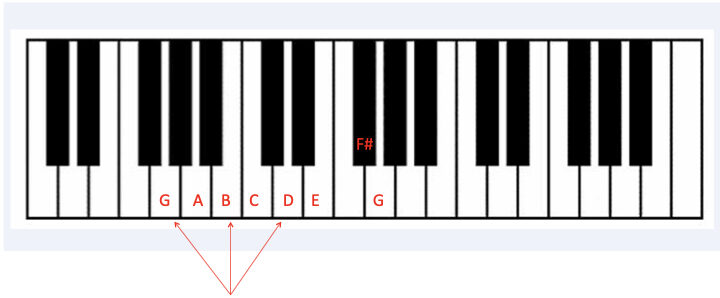
This chord is built on G, and therefore we refer to G as the root of the chord. The G chord doesn’t have to be played like this however – other combinations of the notes are still a G chord. We refer to these other orderings as ‘inversions’.
Harmonics and Chords
A major chord (the first 3rd and 5th notes of the scale) sound ‘right’ when played together – but why is that ?
Think back to the harmonics explained in the chapter What is Music, where the string is caused to vibrate twice / three times / four times along its length. We now know that when the string vibrates (the first harmonic) this gives us the octave – i.e. the same note name but higher.
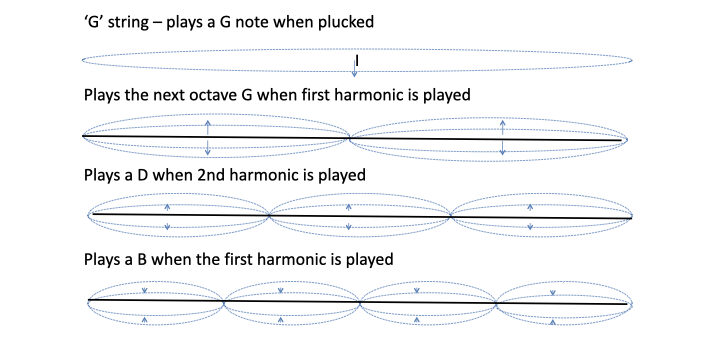
- ▪Root string & 1st harmonic – G
- ▪2nd harmonic – D
- ▪3rd harmonic – B
- •Notes of G major scale – G, B and D
This is why the major scale sounds ‘right’ ! Harmonics are also why 7th chords work, circle of 5ths, etc – but that’s a more advanced topic …..
Major and Minor Chords
So far we have talked about major chords, which is a chord based on notes 1, 3 and 5 of the major scale. If we play a chord using the notes of the G scale but starting on A, we have A C and E.
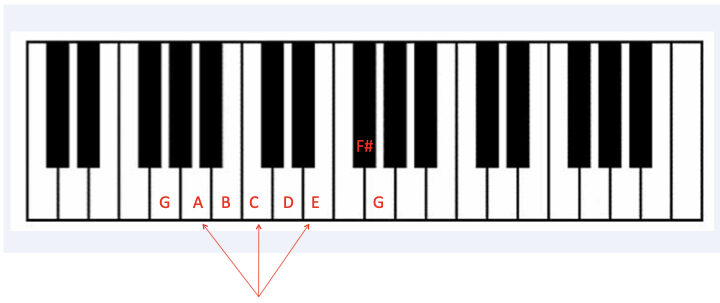
Does this sound the same as when we played an A chord earlier by moving the G chord up 2 frets? No it doesn’t ! – so why is that?
If we play a barre chord in one position on the guitar, and then move that shape along the neck, the chord changes. Moving G chord to A chord by shifting 2 frets means that each note of the G chord increases by 2 frets – i.e. 2 semi tones.
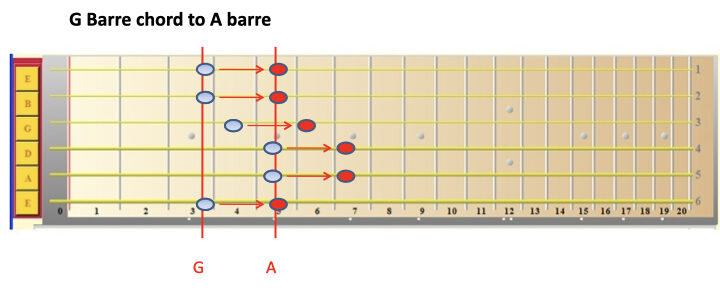
If we repeat the chord shift on the piano , and move every note of the G chord up 2 semitones – what notes do we get ? The answer is A C# E. To make an A chord which uses the notes of the key of G we have to drop the 2nd note by a semi tone, so that we get the notes A C and E.
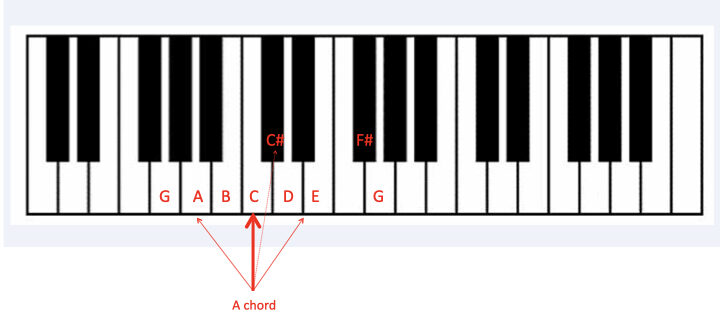
This gives us a chord which is known as a minor chord. We can hear the difference in the sound of the two chords if we play the G major chord and the A minor chord – they are obviously not the same. IF we look at the intervals between the notes of the two chords, we can see that they are not the same. The intervals between the notes can be seen by coutning the number of piano keys between each one (each key is half a tone).
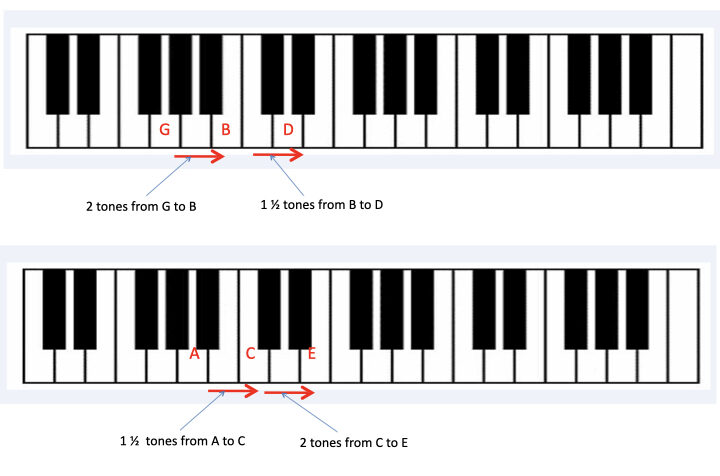
We can see that the G major chord has 2 tones between the first two notes and a tone and a half between the second two notes. The A minor chord has a tone and a half between the first two noes, and two tones between the second two notes.
Terminology
- A major third interval is an interval of 2 whole tones – e.g. G to B
- A minor third is an interval of 1 ½ tones – e.g. A to C
- A major chord is one where the first two notes of the chord are separated by a major 3d (e.g. G B D)
- A minor chord is one where the first two notes of the chord are separated by a minor 3rd – e.g. A C E
Finding the major chords
If we think of the key of G, the notes of the scale (and therefore the notes available in the key) are:
G – A – B – C – D – E – F# – G
If we build up triads (chords) on each note of the scale (using ‘Play a Note, Miss a note’, etc) we get the following. We can work out the type of chord by working out the interval between each of the notes. (Major chord is 2 tones followed by 1.5 tones, Minor chord is 1.5 tones follows by 2 tones)
| Starting Note | Chord Notes | Chord Type |
| G | G – B – D | Major |
| A | A – C – E | minor |
| B | B – D – F | minor |
| C | C – E- G | Major |
| D | D – F# – A | Major |
| E | E – G – B | minor |
| F# | F# – A – C | diminished. This is a special case ! |
From the above, we can see that we find major chords on the first, fourth and fifth degree of the scale. (G is 1, A is 2, B is 3 and so on). These chords can be referred to as chord 1, 4 and 5, in the key of G. This is often written in roman numerals – i.e
I = G major
IV = C major
V = D major
Note – the above is for the key of G !! It is impolrtant to recognise that when we start talking about chords by number, those number relate to the key we are in. So chord V in the key of G is a D major. Chord V (chord 5) in the key of C would be a G major, because the notes of the scale of C and C, D, E, F, G, A, B, C, so G is the 5th note in the scale.
The Scrabble Bag
A lot of people struggle with the conecpts above at first, so I often use the ‘scrfabble bag’ as a metaphor. IMagine a scrabble bag with 7 letters in it. THese letters represent the notes available in your key. THere wil be 1 A, 1 B, 1 C, etc until we have used all the letters from AS to G. Some of these letters will be modified with sharos or flats. So for our scrabble bag foro the key of G, there will be an F# rather than an F.
The letters in the bag compsoire the notes in the key. If we lay them out in order, starting with our key letter, then we will have the notes of the related scale – e.g. the G major scale in our G major scrabble bag. The only thing we have to remember is that once we get to G, we start again with A. This means that when we empty out the G major scrabble bag and put the letters in order we get;
G – A – B – C – D – E – F#
With the letters in the right order, we can number then, starting at 1. These are known as the degrees of the scale. So for the key of G;
- 1 = G
- 2 = A
- 3 = B
- 4 = C
- 5 = D
- 6 = E
- 7 = F#
We know the major chords ar at degrees 1, 4 and 5 (I, IV and V) so they must be G, C and D. We can then build up the notes of the chord using the ‘Use a note, Miss a note’ process, so we end up with
- I (chord 1) = G – B – D
- IV (chord 4) = C – E – G
- V (chord 5) = D = F# – A
Lets try this with another key – Bb. (if you dont know the notes which will be in the bag, you can work this out – see the Scales chapter).
- Scrabble bag contains Bb, C, D, Eb, F, G, A
- Chords I, IV and V are Bb, Eb and F respectively
- Chord I = Bb – D – F
- Chord IV = Eb – G – Bb
- Chord V – F – A – C